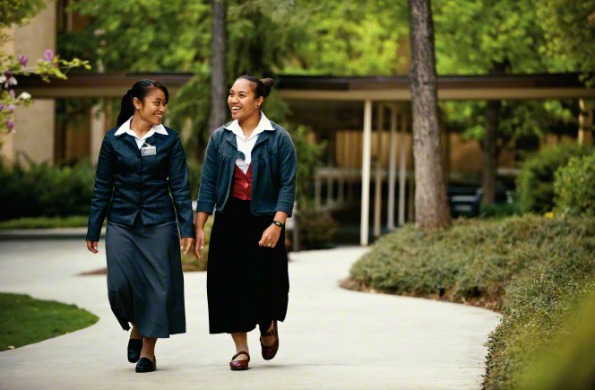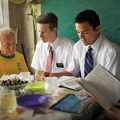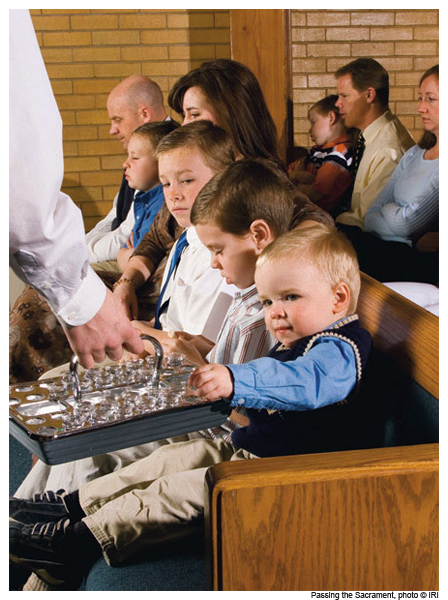The first Sunday that I attended with the Bishop and his assistants (Counselors). They were dressed in suits and wore black name tags. Not one other person in the congregation nor leadership was wearing a name tag — only those two young men.
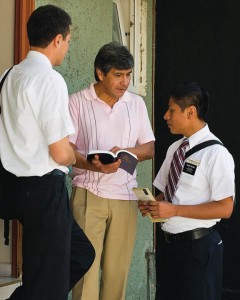 I asked my friend, “Who are those guys?” He explained that they were full-time missionaries for the Church. Having been intrigued by missionary service since I was about 10 years old, I then expressed interest in learning what the missionaries do.
I asked my friend, “Who are those guys?” He explained that they were full-time missionaries for the Church. Having been intrigued by missionary service since I was about 10 years old, I then expressed interest in learning what the missionaries do.
I was especially interested in what two missionaries in the United States do. My view of missionary service was going out into the wilderness of Africa or something of that nature.
My friend mentioned that sometimes his family had the missionaries over to their home for dinner, which prompted me to say, “Hey, next time they are over at your house, let me know. I’m interested to find out what they do.” Ironically — or planned that day after church — I found myself sitting across the dining room table from those two young men.
As we spoke of what they do and why they were doing it, they explained that they share a message about Jesus Christ and asked if it would be okay if they shared it with me. Believing that they were simply practicing on me, I said, “Sure!” I was also interested to hear what they had to say.
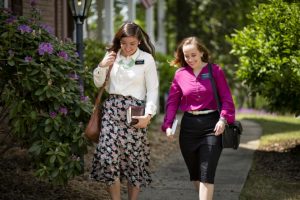 That is what any proselyting missionary does: share a message about Jesus Christ. Full-time missionaries share this message, sun up to sun down, for 18 to 24 months. Most are between the ages of 19 and 26 years old but older single women and married couples also serve as full-time missionaries.
That is what any proselyting missionary does: share a message about Jesus Christ. Full-time missionaries share this message, sun up to sun down, for 18 to 24 months. Most are between the ages of 19 and 26 years old but older single women and married couples also serve as full-time missionaries.
The Church of Jesus Christ of Latter-day Saints sends missionaries to many countries all over the world to share not only the message of Jesus Christ but also the message of the restored gospel and a living prophet and apostles. This is what Latter-day Saints call proclaiming the gospel.
Full-time missionary service begins in the Missionary Training Center (MTC). The Church has 17 training centers in various parts of the world. The most well-known is the center in Provo, Utah. New missionaries are trained in the study and application of the scriptures in their own lives, how to talk about the scriptures with others, and how to effectively teach about the basic beliefs of the Church.
If they are to go to their missions speaking in their native language, the missionaries usually spend only a few weeks in the MTC. Those who are to go forth to teach in a new language usually spend two months in the MTC, and their training includes language instruction.
Once in their assigned area, called a mission, the new missionaries are assigned to a companion who has been serving as a full-time missionary for several months and is well-trained.
 Whether new or seasoned, all full-time missionaries spend their days seeking out people who might be interested in their message, teaching those who have invited the missionaries into their homes and completing community service inside their designated area within the mission boundaries.
Whether new or seasoned, all full-time missionaries spend their days seeking out people who might be interested in their message, teaching those who have invited the missionaries into their homes and completing community service inside their designated area within the mission boundaries.
After a period each morning of personal and companionship scripture study and planning, most missionaries are out working by 9 a.m. and work until about 9 p.m., breaking only for meals and performing service. Part of one day each week is set aside as a Preparation Day where the missionaries are encouraged to write letters to their family and friends, buy their groceries, do their laundry and rest.
Single full-time missionaries are assigned a partner or companion — usually in pairs but occasionally in threesome partnerships. Every 1-4 months, the companionships are shuffled so that a full-time missionary will have 3 or more companions by the end of their service. Married full-time missionaries serve their entire mission service together.

